View in other NatureServe Network Field Guides
NatureServe
Montana
Utah
Wyoming
Idaho
Wisconsin
British Columbia
South Carolina
Yukon
California
New York
Arctic Shrew - Sorex arcticus
State Rank Reason (see State Rank above)
Species has only been observed in the state at 3 sites. Data to assess status is unavailable.
General Description
The Arctic Shrew is a medium to large sized shrew. Adults possess a distinctive tri-colored pelage; the dorsum is very dark brown to black, the sides are lighter brown, and the underparts are grayish-brown. The tail is distinctly bicolored, darker above and lighter below. Ranges in external measurements (in millimeters) are: total length 100 to 125, tail length 36 to 45, hind foot 12 to 15, and a mass of 5.3 to 13.5 grams. Condylobasal length of the skull is 19.0 to 20.0 millimeters, palatal length is 8.1 to 8.7 millimeters, maxillary breadth is 4.8 to 5.5 millimeters, and the length of the maxillary tooth row is 6.7 to 7.9 millimeters (Junge and Hoffmann 1981, Van Zyll de Jong 1983, Kirkland and Schmidt 1996). The skull has 32 teeth (dental formula: I 3/1, C 1/1, P 3/1, M 3/3); the 5 upper teeth with single cusps that are posterior to the first incisor are termed the unicuspids (U), and include 2 incisors, 1 canine, and 2 premolars. There is a medial tine on I1, and U3 is as large or larger than U4. On the lower jaw (mandible), the pigment is in two or three segments on I1 (the posterior extent of pigment on the ventromedial edge is restricted to about the first third), the height of the coronoid process is more than 4.3 millimeters, and the length of the dentary is greater than 7.8 millimeters (Carraway 1995).
Diagnostic Characteristics
Throughout its range, the Arctic Shrew is the only member of the subgenus Sorex, and is distinguished by its well-developed postmandibular canals and lack of pigmented ridges on the unicuspids (Junge and Hoffmann 1981, Kirkland and Schmidt 1996). In northeastern Montana, no other Sorex shrew is as large in skull or body measurements as the Arctic Shrew; the tricolored pelage is also distinctive.
Species Range
Montana Range
Range Descriptions
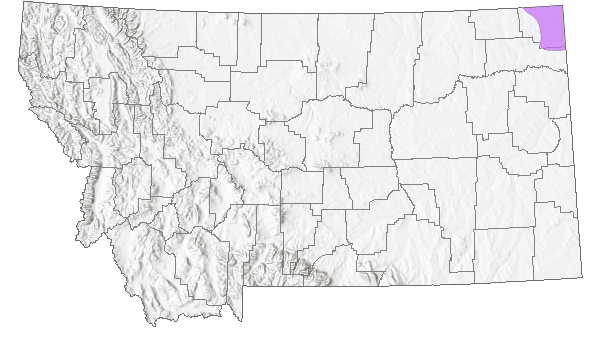
 Native
Native
Western Hemisphere Range
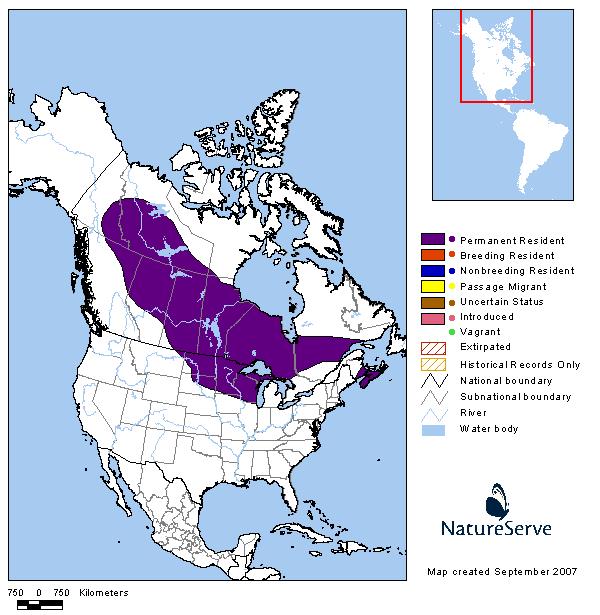
Observations in Montana Natural Heritage Program Database
Number of Observations: 5
(Click on the following maps and charts to see full sized version)
Map Help and Descriptions
Relative Density
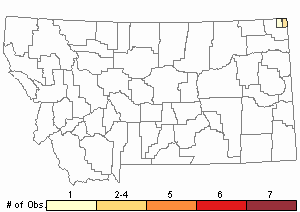
Recency
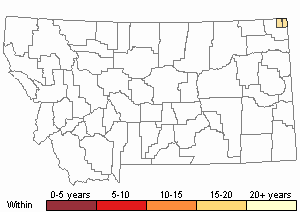

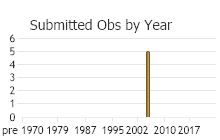
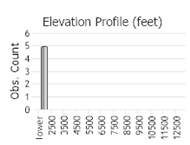 (Observations spanning multiple months or years are excluded from time charts)
(Observations spanning multiple months or years are excluded from time charts)
Migration
No information is available on movements.
Habitat
Few descriptions of habitat use by Arctic shrew in Montana are available . All individuals have been captured in wet meadow habitat adjacent to marshes or in the sandy flats of creek flood plains. Dominant plants included Agropyron repens, Sonchus spp., Juncus balticus, Carex spp., Agropyron smithii, Distichlis spicata; Hordeum jubatum was also present (Perry 2000, Foresman 2012).
National Vegetation Classification System Groups Associated with this Species
Wetland and Riparian
Alkaline - Saline Wetlands
Peatland
Riparian and Wetland Forest
Riparian Shrubland
Wet Meadow and Marsh
Food Habits
Generally, Arctic Shrews feed largely on insects; the diet includes moth larvae, grasshoppers, larval and adult beetles, fly larvae, aquatic insects, and other terrestrial invertebrates (Jones et al. 1983, Kirkland and Schmidt 1996). Destructive larch sawfly larvae seasonally constitute a large part of its diet (Buckner 1964). The diet in Montana has not been reported or studied.
Ecology
No studies have been completed for Arctic Shrew in Montana. Studies from other areas of the species' range reveal Arctic Shrews are active throughout the year, and are most often nocturnal (Baird et al. 1983, Kirkland and Schmidt 1996). All Montana captures have occurred in late July (Perry 2000, Foresman 2012). Other small mammal associates of Arctic Shrew across its range include the shrews Sorex cinereus, S. hoyi, and S. palustris (Wrigley et al. 1979, Kirkland and Schmidt 1996); S. cinereus has been captured in sympatry with the Arctic Shrew in Montana (Perry 2000, Foresman 2012).
Vital statistics, measures of population trends, and estimates of population density are rarely available. Home range size in Manitoba was 5913 square meters (Buckner 1966). Population density in Manitoba tamarack bogs was 4.1 to 5.1 per hectare in July and 7.3 to 7.8 per hectare in September; in Wisconsin marsh habitat, density was 8.6 per hectare (Kirkland and Schmidt 1996). There is high population turnover, with loss of approximately 80% of each generation prior to sexual maturity (Buckner 1966). Predators are largely unreported, but include the Great Horned Owl and weasels (Jones et al. 1983, Schowalter et al. 2002). Non-human predators in Montana are not known.
Reproductive Characteristics
No reproductive studies or data are available for Arctic Shrew in Montana. Studies from other areas of the species' range indicate this species' reproductive season extends from February to August in Wisconsin, and April to September in Minnesota. Gestation lasts 2 to 3 weeks, with a lactation period an additional 3.0 to 3.5 weeks. Litter size is 4 to 9, with an average of 2 litters (1 to 3) produced per year; a few females breed in consecutive years. Young-of-the-year sometimes breed late in the first summer in Minnesota. Mortality of nestling Arctic Shrews in the first month of life is estimated to be 50% or more, and 80% of cohort mortality occurs before sexual maturity is reached. Longevity may reach 18 months; adults surviving through the winter are not present in samples after July (Baird et al. 1983, Kirkland and Schmidt 1996).
Management
No management needs are identified nor have any measures been enacted for the conservation of Arctic Shrew in Montana; the only occurrence so far known is on a National Wildlife Refuge. Nevertheless, wetland drainage or alteration has the potential to negatively impact local populations. Additional surveys for Arctic Shrew can provide the basis for development of conservation protocols by determining its full distribution in Montana, the array of habitats in which it occurs, its relative abundance in different habitats, and, if properly designed, an idea of how different habitat disturbances affect this shrew at the margin of its global range.
Stewardship Responsibility
References
- Literature Cited AboveLegend:
 View Online Publication
View Online Publication Baird, D. D., R. M. Timm, and G. E. Nordquist. 1983. Reproduction in the arctic shrew, Sorex arcticus. Journal of Mammalogy 64:298-301.
Baird, D. D., R. M. Timm, and G. E. Nordquist. 1983. Reproduction in the arctic shrew, Sorex arcticus. Journal of Mammalogy 64:298-301. Buckner, C.H. 1964. Metabolism, food capacity and feeding behavior in four species of shrews. Canadian Journal of Zoology 42: 259-79.
Buckner, C.H. 1964. Metabolism, food capacity and feeding behavior in four species of shrews. Canadian Journal of Zoology 42: 259-79. Buckner, C.H. 1966. Populations and ecological relationships of shrews in tamarack bogs of southeastern Manitoba. Journal of Mammalogy 47(2):181-194.
Buckner, C.H. 1966. Populations and ecological relationships of shrews in tamarack bogs of southeastern Manitoba. Journal of Mammalogy 47(2):181-194. Carraway, L.N. 1995. A key to recent Soricidae of the western United States and Canada based primarily on dentaries. Occasional Papers of the Natural History Museum, University of Kansas (175):1-49.
Carraway, L.N. 1995. A key to recent Soricidae of the western United States and Canada based primarily on dentaries. Occasional Papers of the Natural History Museum, University of Kansas (175):1-49. Foresman, K.R. 2012. Mammals of Montana. Second edition. Mountain Press Publishing, Missoula, Montana. 429 pp.
Foresman, K.R. 2012. Mammals of Montana. Second edition. Mountain Press Publishing, Missoula, Montana. 429 pp. Jones, J.K., D.M. Armstrong, R.S. Hoffmann and C. Jones. 1983. Mammals of the northern Great Plains. University of Nebraska Press, Lincoln. 379 pp.
Jones, J.K., D.M. Armstrong, R.S. Hoffmann and C. Jones. 1983. Mammals of the northern Great Plains. University of Nebraska Press, Lincoln. 379 pp. Junge, J.A. and R.S. Hoffmann. 1981. An annotated key to the long-tailed shrews (genus Sorex) of the United States and Canada, with notes on middle American Sorex. Occasional Papers of the Museum of Natural History, the University of Kansas 94: 1-48.
Junge, J.A. and R.S. Hoffmann. 1981. An annotated key to the long-tailed shrews (genus Sorex) of the United States and Canada, with notes on middle American Sorex. Occasional Papers of the Museum of Natural History, the University of Kansas 94: 1-48. Kirkland, G. L. and D. F. Schmidt. 1996. Sorex arcticus. American Society of Mammalogists, Lawrence, KS. Mammalian Species No. 524:1-5.
Kirkland, G. L. and D. F. Schmidt. 1996. Sorex arcticus. American Society of Mammalogists, Lawrence, KS. Mammalian Species No. 524:1-5. Perry, N. 2000. Baseline inventory of small mammals at Medicine Lake National Wildlife Refuge. Unpublished report to Medicine Lake National Wildlife Refuge, Medicine Lake, Montana. 10 pp.
Perry, N. 2000. Baseline inventory of small mammals at Medicine Lake National Wildlife Refuge. Unpublished report to Medicine Lake National Wildlife Refuge, Medicine Lake, Montana. 10 pp. Schowalter, D. B., L. Engley, and R. Digby. 2002. Records of Alberta small mammals through analyses of great horned owl pellets. Blue Jay 60:153-169.
Schowalter, D. B., L. Engley, and R. Digby. 2002. Records of Alberta small mammals through analyses of great horned owl pellets. Blue Jay 60:153-169. Van Zyll de Jong, C.G. 1983. Handbook of Canadian mammals. 1. Marsupials and insectivores. National Museum of Natural Sciences, National Museums of Canada, Ottawa, Canada. 210 pp.
Van Zyll de Jong, C.G. 1983. Handbook of Canadian mammals. 1. Marsupials and insectivores. National Museum of Natural Sciences, National Museums of Canada, Ottawa, Canada. 210 pp. Wrigley, R.F., J.E. DuBois, and H.W. Copland. 1979. Habitat, abundance and distribution of six species of shrews in Manitoba. Journal of Mammalogy 60:505-520.
Wrigley, R.F., J.E. DuBois, and H.W. Copland. 1979. Habitat, abundance and distribution of six species of shrews in Manitoba. Journal of Mammalogy 60:505-520.
- Additional ReferencesLegend:
 View Online Publication
View Online Publication
Do you know of a citation we're missing?
- Web Search Engines for Articles on "Arctic Shrew"
- Additional Sources of Information Related to "Mammals"





